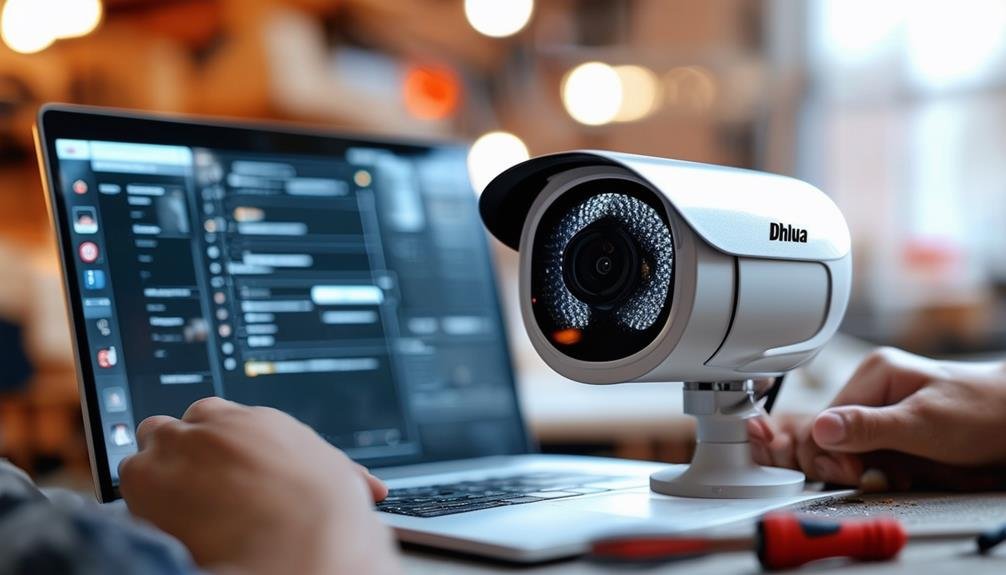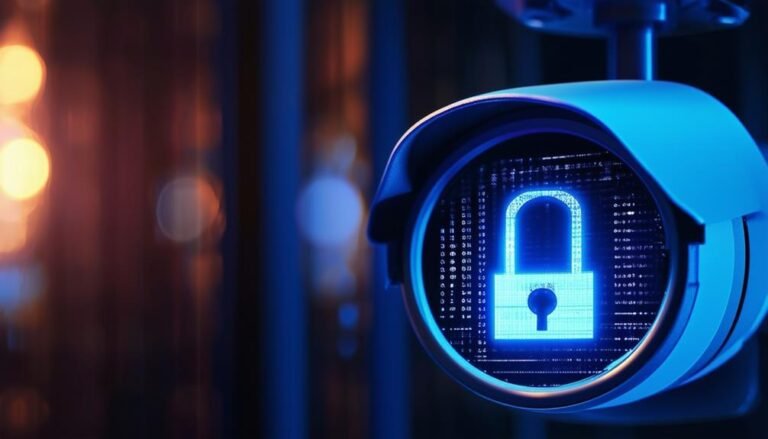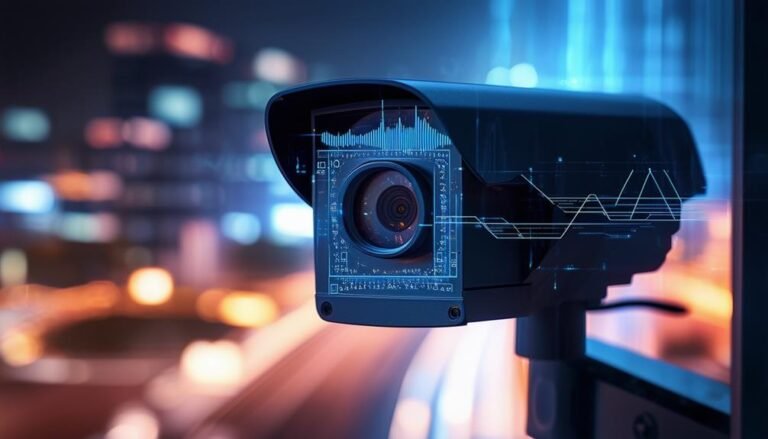You can reset your Dahua IP camera without a reset button by accessing its web interface or using configuration software. First, make sure your camera's powered on and connected to your network. Enter the camera's IP address in your browser to access the settings. Log in with your credentials, then navigate to the network settings where you can find the reset option. Alternatively, the configuration software can automatically detect your camera and offer a reset function. After the reset, you'll need to reconfigure settings. There's more to explore about managing your camera effectively.
Understanding Dahua IP Camera Functions
Dahua IP cameras come with several essential functions that enhance your surveillance experience. These features empower you to monitor your surroundings effectively while giving you the freedom to customize your security setup. One of the standout functions is advanced motion detection. You can set the camera to alert you only when it detects movement, allowing you to focus on what truly matters without unnecessary distractions.
Another vital function is remote access. With Dahua IP cameras, you can view live feeds from anywhere, whether you're at home, at work, or on vacation. This level of accessibility means you're always connected to your property, providing peace of mind. You'll also find the ability to record video locally or to the cloud, ensuring that your footage is always safe and retrievable whenever you need it.
Additionally, these cameras often come equipped with night vision capabilities. This allows you to maintain surveillance even in low-light conditions, supporting 24/7 security. The intelligent video analytics feature can also help you receive notifications about specific events, like line crossing or loitering, making your surveillance smarter and more efficient.
Lastly, Dahua IP cameras support various resolutions, letting you choose the level of detail that suits your needs. This flexibility means you can adapt your surveillance according to your environment, maximizing your security while embracing the freedom to protect what matters most to you.
Accessing the Camera's Web Interface
To access your IP camera's web interface, you'll first need to connect it to your network. This is essential for managing and configuring your camera settings effectively. Make sure your camera is powered on and plugged into your router via an Ethernet cable or connected wirelessly if it supports Wi-Fi. Once it's connected, follow these steps to access the web interface.
- Open a web browser on your computer or mobile device.
- Type in the camera's IP address in the address bar. If you don't know the IP, you can find it using network scanning tools or in your router's connected device list.
- Hit Enter, and you should be prompted to log in.
Here's a quick reference table to help you with common settings once you're logged in:
| Setting | Description | Location |
|---|---|---|
| Video Settings | Adjust resolution and frame rate | Main Menu > Video Configuration |
| Network Settings | Configure IP and subnet mask | Main Menu > Network Configuration |
| User Management | Add or remove users | Main Menu > User Management |
| Motion Detection | Set up alerts and sensitivity | Main Menu > Event Configuration |
| System Info | Check firmware and status | Main Menu > System Information |
Once you're on the web interface, you'll have the freedom to customize your camera settings as needed, ensuring it fits perfectly into your surveillance needs. Enjoy exploring!
Using Configuration Software
Sometimes, using configuration software can simplify the process of managing your IP camera. Instead of wrestling with web interfaces or physical buttons, this software brings a user-friendly approach to configure settings and perform resets. By downloading the appropriate configuration software from Dahua's official site, you can gain access to a suite of tools designed specifically for your camera model.
Once you've installed the software, launch it and connect your camera to your network. The software will typically scan for all connected devices, displaying them in a neat list. You can easily identify your IP camera by its IP address or model number. This visual representation allows you to manage multiple cameras simultaneously, giving you more control and flexibility.
To reset your camera, navigate to the settings menu within the software. You'll often find an option labeled 'Restore Factory Settings' or 'Reset'. Just click that, confirm your choice, and the camera will revert back to its original settings. This method is not only straightforward but also decreases the likelihood of making errors compared to manual resets.
Using configuration software means you're not limited to basic functions; you can also adjust advanced settings, update firmware, and troubleshoot issues, all from one central interface. It empowers you to take full control of your IP camera, ensuring you get the most out of your security system without unnecessary hassle.
Performing a Network Reset
If you're experiencing connectivity issues with your IP camera, performing a network reset can help restore its connection to your network. This process can seem intimidating, but it's quite straightforward and can free you from the frustration of a disconnected camera.
Start by verifying your IP camera is powered on and connected to your network. You'll need access to your computer or mobile device since you'll perform the reset through configuration software. Open the software and locate your camera in the device list. If it isn't showing up, you might need to enter its IP address manually.
Once you've found your camera, navigate to the network settings. Here, look for an option that says "Reset Network" or something similar. Click on it, and confirm the action. This will reset the network settings back to factory defaults, meaning you'll have to reconfigure your Wi-Fi credentials and any other network-specific settings.
After the reset, disconnect and reconnect the camera to your network. You'll want to verify that the camera is picking up the correct network and that the connection is stable.
Troubleshooting Common Issues
What should you do when your IP camera isn't functioning as expected? First, check your network connection. Make sure your camera's connected to your Wi-Fi or wired network. If it's wired, ascertain the cable's securely plugged in on both ends. For Wi-Fi, confirm that the camera is within range of your router and that there aren't any obstructions.
Next, verify that the camera's powered on. Look for indicator lights; if they're off or flashing erratically, there might be a power issue. Try unplugging the camera for a few seconds before plugging it back in to see if that resolves the problem.
If you're still having trouble, access the camera's settings through your browser or app. Verify that the IP address is correct and hasn't changed. Sometimes, a simple IP conflict can cause issues. If you're using DHCP, consider switching to a static IP to avoid future conflicts.
Another common issue is firmware. Outdated firmware can lead to performance problems. Check the manufacturer's website for any available updates and follow their instructions to update your camera.
Lastly, if none of these steps work, consider resetting your camera to factory settings. You may need to do this through the software if there's no physical reset button. It's a hassle, but it can often resolve persistent issues.
With these troubleshooting tips, you should be able to get your IP camera back up and running, allowing you to maintain that sense of freedom and peace of mind you desire.
Frequently Asked Questions
Can I Reset the Camera Remotely Without Physical Access?
You might think you can reset your camera remotely, but it often requires physical access to the device. If you've set up remote management features, you might have some luck through the camera's software interface. However, it's generally tricky without a reset button. Embracing the freedom of technology means understanding its limits. So, explore your camera's settings and see if there's an option to reboot or restore factory settings remotely.
What to Do if the Camera Is Not Responding?
If your camera's not responding, don't panic. First, check the power supply; it might just need a restart. Verify the network connection is stable and that the camera's firmware is up to date. If it still doesn't respond, try accessing the camera's settings through its app or web interface. Sometimes, a simple reboot can work wonders. If all else fails, consider reaching out to tech support for further assistance.
Will Resetting Affect My Saved Settings?
Resetting your camera will typically erase all your saved settings. It's like starting fresh, so you'll need to reconfigure everything to match your previous setup. If you value your current settings, consider backing them up first. Once you reset, you'll regain control, but it'll require some effort to restore your preferences. Embrace the opportunity to customize your setup anew, ensuring it reflects your unique needs and desires for freedom in surveillance.
How Do I Find My Camera's IP Address?
To find your camera's IP address, you can start by checking your router's connected devices list. Log into your router's interface, usually found at a specific IP like 192.168.1.1. Look for a section labeled "Device List" or "Connected Devices." Your camera should be listed there. Alternatively, you can use software tools like Angry IP Scanner to scan your network and identify all connected devices, including your camera's IP address.
Is There a Way to Recover Lost Configurations After a Reset?
Imagine your camera's settings as a vibrant garden, flourishing with configurations. After a reset, that garden may seem barren, but don't lose hope. If you've backed up your configurations before, you can restore that lush landscape. Without a backup, though, you might need to start anew, planting each setting carefully. Embrace the freedom to redesign your camera's setup, nurturing it back to life, even if it takes time to bloom again.



